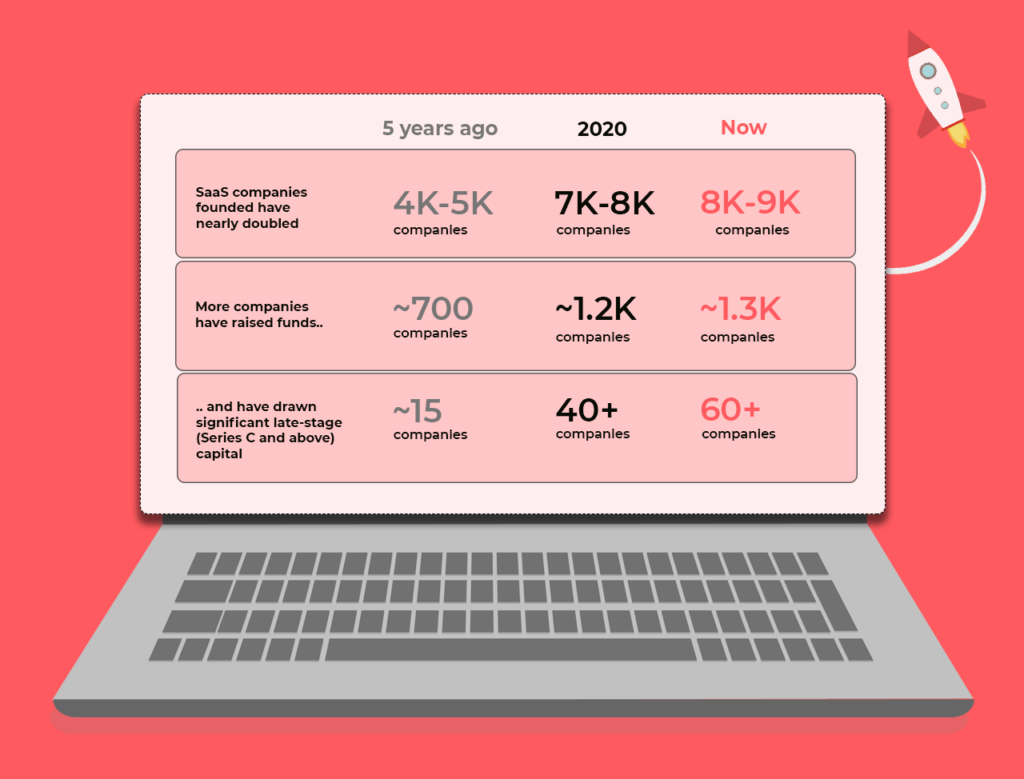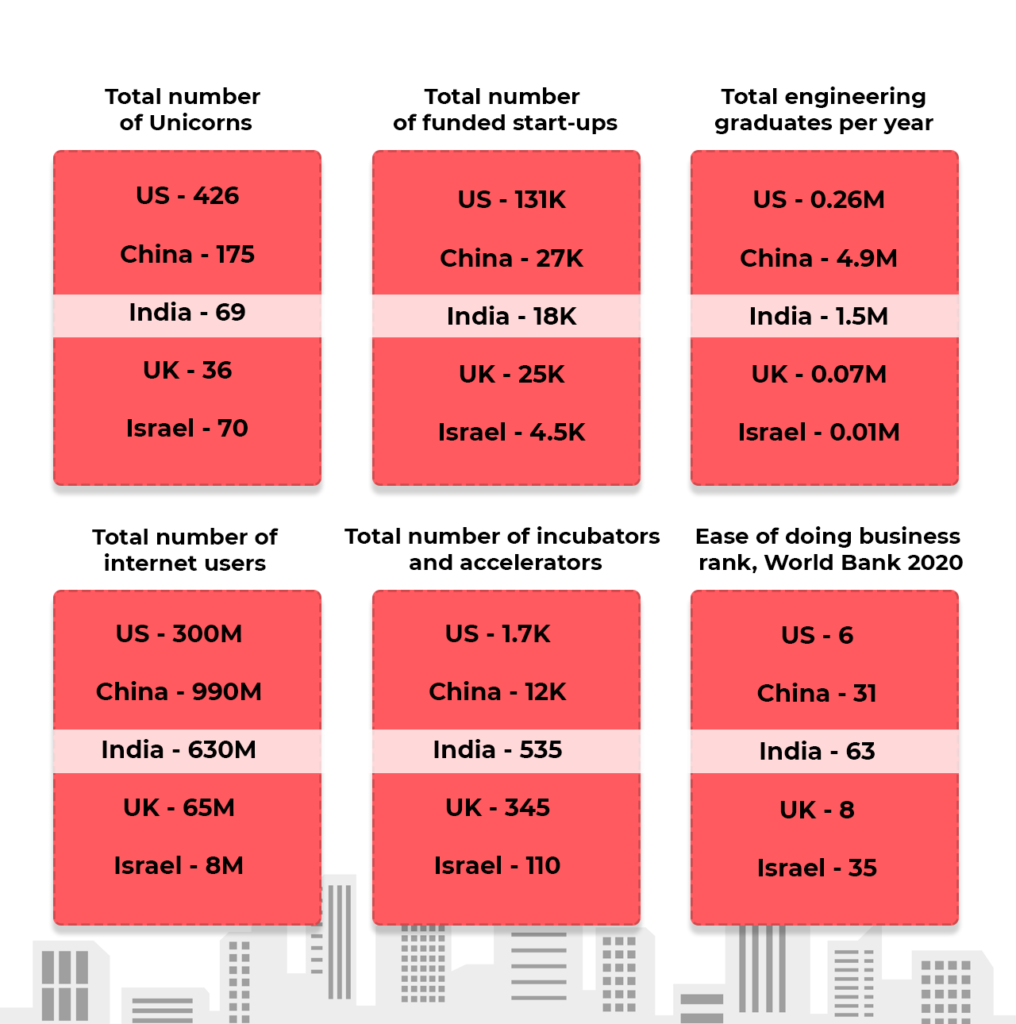
The Maturing Indian SaaS Landscape: Key Highlights from ‘India SaaS Report’ by Bain & Co
The software-as-a-service (SaaS) industry in India is on the cusp of unlocking a $1 trillion opportunity within the next 10 years.
As the SaaS landscape matures in India, we are seeing increased investor activity across early-stage as well as later-stage SaaS companies.
Recently, Bain & Company released a comprehensive report on the Indian SaaS system. The report titled “India SaaS Report 2021” talks about the next wave of SaaS companies in India.
So, in this article, we’ll discuss the key highlights from the report to give you an overview of the ever-evolving landscape of Indian SaaS companies.
Let’s begin.
An overview of the Indian SaaS landscape
As per the report, the investment in Indian SaaS companies increased by 170% in 2021, reaching roughly $4.5 billion.

Heightened investor activity has led to an 85% increase in the average value of the seed round in early-stage companies. Similarly, for late-stage SaaS companies, there has been a 20% increase in the average value of Series D+ funding rounds.
In 2021, India had 35 SaaS companies with $20 million+ annual recurring revenue (ARR). This equates to a 7-fold increase in the last 5 years.
There are 4 ways in which value creation is taking place in Indian SaaS companies –
- Increased exits – From 2018 to 2021, the number of Indian SaaS exits increased by 100%. The number of exits grew from 6 to 12, with Freshworks’ IPO a particular high point.
- Better capital efficiency – Indian SaaS companies have impressive ARR-to-funding ratios. Some of these companies even outperformed many global SaaS players in 2021.
- Talent pool creation – Indian SaaS companies currently employ more than 62,000 people in India. This large talent pool has professionals with SaaS-relevant skills.
- Cascading – There are more than 250 new Indian SaaS companies that have been formed by former employees of Indian SaaS companies. This cascade effect has led to the employment of more than 5000 employees.
When it comes to classifying the Indian SaaS ecosystem, there are 3 major archetypes. Those are –
- Horizontal business software – It includes some noteworthy themes like enterprise collaboration, HR tech, conversational AI, and events tech.
- Horizontal infrastructure software – It includes themes like cybersecurity, DevOps, data management, and data observability.
- Vertical business software – It includes EdTech, healthcare, logistics tech, and eCommerce enablement.
Among these 3 subsegments, horizontal business software is the largest. It accounts for more than half of all SaaS funding in India. However, in the vertical business software, we have seen a 100% year-over-year growth which is quite impressive.
Here’s another interesting statistic – Due to the growing investor activity in the Indian SaaS ecosystem, the segment is poised to reach $30 billion revenue by 2025, capturing 8-9% of the global SaaS market.

All in all, the Indian SaaS industry is looking like a flourishing ecosystem.
Key characteristics of Indian SaaS companies
The report highlights the following key characteristics of Indian SaaS founders and their winning SaaS companies –
- Winning approach – Indian SaaS founders have been investing time in achieving the right product-market fit, optimizing pricing, and maintaining a strong focus on customer success.
- Vision – Having a differentiated product vision along with a well-defined strategy.
- Global organizations – Setting up global organizations with a culture of strong teamwork and innovation.
As per the report, Indian SaaS companies have the following three focus areas that they consistently pay attention to –
- Pricing and packaging – To serve a wide range of customer segments and increase profit in each price segment.
- Entering adjacent markets – To drive growth across products and geographies.
- Setting up efficient sales channels – To expand into new customer segments and geographies, and improve scaling efficiency.
Ecosystem enablers in India
India has a thriving ecosystem of SaaS enablers. These include investors (domestic and global), various incubators and accelerators, and numerous events or initiatives sponsored by communities like NASSCOM.
These enablers can take several initiatives to strengthen India’s SaaS ecosystem. Here’s how –
- The government can simplify regulations related to IPOs as well as taxation. It can also play a role in training talent.
- Investors can help SaaS founders by offering them mentorship along with funding. They can play an important role in improving products, creating sales strategies, and giving a push to hiring.
- Founders can share knowledge with other SaaS founders and focus on networking to help one another grow.
- Corporates can provide funds and offer mentorship to Indian SaaS companies.
- Educational institutions can focus on incorporating vocational training to develop talent with relevant skills.
One can also look at countries like US and Canada for inspiration since they have successfully implemented such initiatives to support SaaS growth.
India already has one of the top 5 startup ecosystems in the world. So, with the help of these enablers, we can expect ample growth in the future for this already maturing SaaS ecosystem.

Conclusion
With growing investor support, Indian SaaS companies are poised to compete with global SaaS players within the next few years. However, it will be critical for companies to focus on improving talent in order to meet the talent demand-supply gap.
India should increasingly focus on skilling graduates with relevant skills as well as reskilling the existing talent pool to equip them for an evolving workplace.
Going forward, India has the potential to establish itself as a true SaaS leader with a specific niche in horizontal infrastructure software and vertical business software.
To read more such insightful articles, check out Dresma’s blogs.

